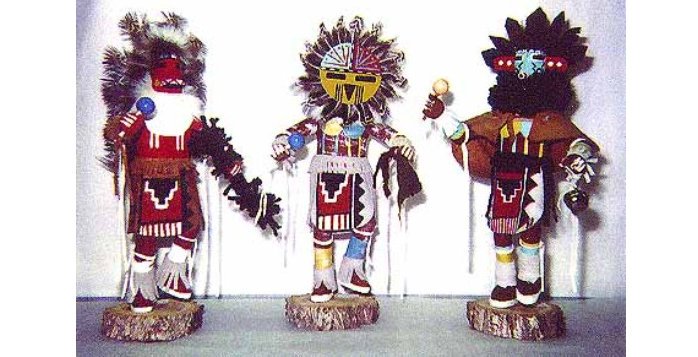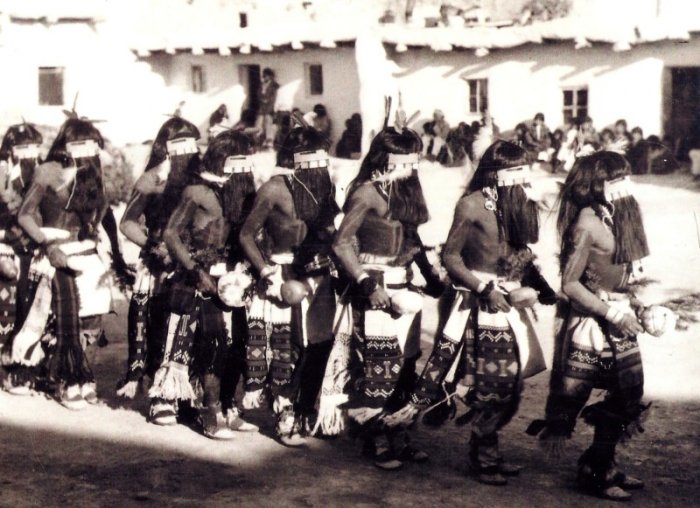Soyal: Hopi Indians’ Winter Solstice Celebration And Arrival Of Katchinas
Ellen Lloyd - AncientPages.com - There are many different kinds of winter solstice celebrations across the world.
The Hopi Indians of Northern Arizona celebrate Soyal and welcome the Kachinas, protective spirits from the mountains. The celebration begins on the shortest day of the year and symbolizes the second phase of Creation at the Dawn of Life
December has been held sacred for over a thousand years. To the Hopi Indians this month is associated with the arrival of the Katchinas (Katsinam ) who bring the Sun back to the world.
In his book, The Oxford Handbook of North American Archaeology, Timothy R. Pauketat, archaeologist and Professor of anthropology and Medieval studies at the University of Illinois writes that “according to official Hopi history Katsinam are Hopi spirit messengers who send prayers for rain, bountiful harvests, and prosperous healthy life for humankind.
They are friends and visitors who bring gifts and food, as well as messages to teach appropriate behavior and consequences of unacceptable behavior.”
There are over 250 different types of Katsinam and they all represent various beings, from animals to clouds.
The Hopi Indians celebration of Soyal. Credit: Wilder Utopia
During their stay at the Hopi the Katsinam appear in physical form, and they participate in the ceremony dancing and singing. On the first and second Mesa, the Katsinam arrive in February at the Bear Dance ceremony and on the third mesa they come in December celebrating the Soyal ceremony.
Before the Soyal ceremony can take place there are many things that need to be prepared.
The Hopi Indians make prayer sticks of tied feathers and pinyon needles called Pahos to bless the community, including their homes, animals and plants. Children receive small dolls made in the image of the Kachinas and they must learn about hundreds of Katchina spirits.
Sixteen days before the winter solstice, one of the chief kachinas enters the Pueblo.
He is dressed like an old, tired man and appears to have just awakened from a deep slumber. He sings and dance and people follow his every move. But he sings in a very low voice because the songs are sacred and not everyone is allowed to hear them.
“We Hopi are deeply religious people. We follow divine instructions and prophecies received from the caretaker of this world, Maasaw. Our religion teaches us a lifeway of humility, cooperation, respect and earth stewardship.
Soyal celebration. Credit: University of Toronto
We practice our religion with different ceremonies throughout the year which are timed according to phases of the Moon and solstices of the Sun. Many of our ceremonies seek to maintain and improve our harmony with nature, enhance our prospects for good health and long, happy life, and are supplications for rain.
Through our dances we celebrate the renewal of our life pattern, ancient immigration, and a spiritual connection with our ancestral sites.
This together with our farming traditions, ties us both physically and ceremonially to our ancestral land, the Sun, and the cycle of the seasons,” the Hopi themselves say about their annual cycle.
The Katchinas stay with the Hopi for the first half of the Wheel of the Year until the summer solstice, when they return to their home in the mountains.
Written by - Ellen Lloyd – AncientPages.com
Copyright © AncientPages.com All rights reserved. This material may not be published, broadcast, rewritten or redistributed in whole or part without the express written permission of AncientPages.com
More From Ancient Pages
-
 Skadi: Goddess Of Destruction, Giantess And Patron Of Winter Hunters And Skiers In Norse Mythology
Featured Stories | Dec 14, 2017
Skadi: Goddess Of Destruction, Giantess And Patron Of Winter Hunters And Skiers In Norse Mythology
Featured Stories | Dec 14, 2017 -
 Birth Of Good And Evil In Iroquois Beliefs
Featured Stories | Sep 23, 2019
Birth Of Good And Evil In Iroquois Beliefs
Featured Stories | Sep 23, 2019 -
 Ancient Mystery Of America’s Missing Metal – Can The Answer Be Found In Ancient Europe?
Ancient Mysteries | May 18, 2018
Ancient Mystery Of America’s Missing Metal – Can The Answer Be Found In Ancient Europe?
Ancient Mysteries | May 18, 2018 -
 On This Day In History: Berlin Victory Parade Took Place – On September 7, 1945
News | Sep 7, 2016
On This Day In History: Berlin Victory Parade Took Place – On September 7, 1945
News | Sep 7, 2016 -
 Curse Tablets With Messages To The Gods Of The Underworld Found In 2,500-Year-Old Well
Archaeology | Feb 7, 2020
Curse Tablets With Messages To The Gods Of The Underworld Found In 2,500-Year-Old Well
Archaeology | Feb 7, 2020 -
 New Video Footage Reveals Intriguing Viking-Style Shipwreck At The Bottom Of Norway’s Largest Lake Mjøsa
Archaeology | May 5, 2023
New Video Footage Reveals Intriguing Viking-Style Shipwreck At The Bottom Of Norway’s Largest Lake Mjøsa
Archaeology | May 5, 2023 -
 Fossilized Remains Of A Gigantic Jurassic Pterosaur Unearthed In Oxfordshire, UK
Fossils | Jun 5, 2024
Fossilized Remains Of A Gigantic Jurassic Pterosaur Unearthed In Oxfordshire, UK
Fossils | Jun 5, 2024 -
 14th Century Murals With ‘Warrior Saints’ Found In Church Of Ancient City Cherven In Bulgaria
Archaeology | Apr 10, 2020
14th Century Murals With ‘Warrior Saints’ Found In Church Of Ancient City Cherven In Bulgaria
Archaeology | Apr 10, 2020 -
 Intriguing Fragment Of A Byzantine-Era Jar Handle, Dating Back Approximately 1500 Years – Unearthed
Archaeology | Sep 5, 2023
Intriguing Fragment Of A Byzantine-Era Jar Handle, Dating Back Approximately 1500 Years – Unearthed
Archaeology | Sep 5, 2023 -
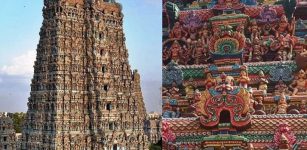 Meenakshi Temple Of Madurai Is Among Most Powerful Sacred Sites For Hindu People
Featured Stories | Apr 29, 2021
Meenakshi Temple Of Madurai Is Among Most Powerful Sacred Sites For Hindu People
Featured Stories | Apr 29, 2021 -
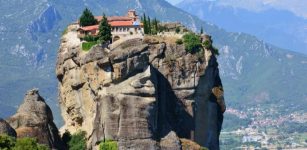 Magnificent Meteora And ‘Suspended In The Air’ Greek Monasteries
Featured Stories | May 5, 2021
Magnificent Meteora And ‘Suspended In The Air’ Greek Monasteries
Featured Stories | May 5, 2021 -
 Swords And Spears Of The Yotvingians – A Long-Forgotten Ancient Warrior Culture Discovered In Poland
Archaeology | Jan 6, 2020
Swords And Spears Of The Yotvingians – A Long-Forgotten Ancient Warrior Culture Discovered In Poland
Archaeology | Jan 6, 2020 -
 On This Day In History: British Forces Captured Gibraltar – On August 3, 1704
News | Aug 3, 2016
On This Day In History: British Forces Captured Gibraltar – On August 3, 1704
News | Aug 3, 2016 -
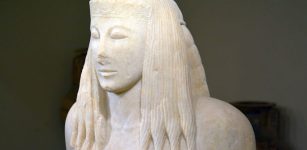 ‘Supernatural’ Sized Daughter Of Thera: Rare Masterpiece Of Greek Antiquity Revealed To The Public
Artifacts | Oct 1, 2022
‘Supernatural’ Sized Daughter Of Thera: Rare Masterpiece Of Greek Antiquity Revealed To The Public
Artifacts | Oct 1, 2022 -
 Seppuku: Ancient Suicide Ritual That Guaranteed Honorable Death Instead For Life In Shame
Ancient Traditions And Customs | Mar 8, 2018
Seppuku: Ancient Suicide Ritual That Guaranteed Honorable Death Instead For Life In Shame
Ancient Traditions And Customs | Mar 8, 2018 -
 Human-Driven Mass Extinction Is Eliminating Entire Branches Of The Tree Of Life – New Study
Biology | Sep 19, 2023
Human-Driven Mass Extinction Is Eliminating Entire Branches Of The Tree Of Life – New Study
Biology | Sep 19, 2023 -
 Aegir – Jotun Lord Of The Stormy Seas Revered And Feared By Norsemen
Featured Stories | Sep 6, 2019
Aegir – Jotun Lord Of The Stormy Seas Revered And Feared By Norsemen
Featured Stories | Sep 6, 2019 -
 Human And Neanderthal Brains Have A Surprising ‘Youthful’ Quality In Common – New Study
Featured Stories | Jan 6, 2023
Human And Neanderthal Brains Have A Surprising ‘Youthful’ Quality In Common – New Study
Featured Stories | Jan 6, 2023 -
 Easter Island Holds Clues To The Disappearance Of People On The ‘Mystery Islands’
Archaeology | May 14, 2021
Easter Island Holds Clues To The Disappearance Of People On The ‘Mystery Islands’
Archaeology | May 14, 2021 -
 Largest Viking-Age Building In Britain Has Been Found In Cumbria!
Archaeology | Feb 18, 2025
Largest Viking-Age Building In Britain Has Been Found In Cumbria!
Archaeology | Feb 18, 2025

